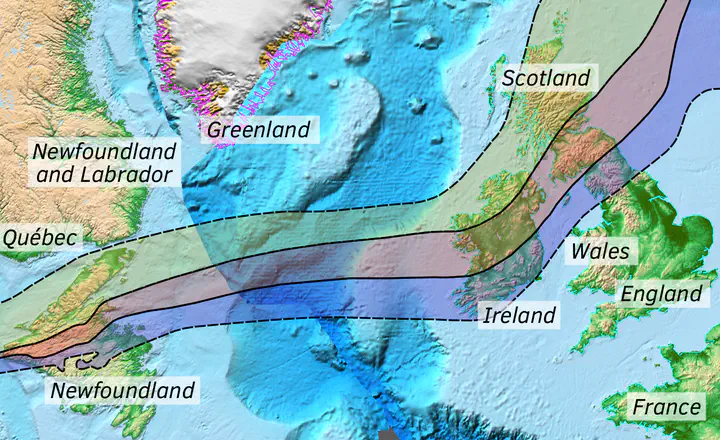Probabilistic surface heat flow estimates assimilating palaeoclimate history: new implications for the thermochemical structure of Ireland
 Plate reconstruction at 100Ma before the opening of the Atlantic Ocean
Plate reconstruction at 100Ma before the opening of the Atlantic OceanAbstract
Regions where surface temperature has increased since past glaciation events, such as Ireland, underestimate the heat output of the Earth unless palaeoclimate corrections are applied. We apply probabilistic techniques to quantify the uncertainty of 22 palaeoclimate‐corrected heat flow estimates in Ireland, which assimilate multiple surface temperature histories associated with 130 ka of glacial oscillation in the British Isles. Heat flow values increase by ∼ 15 mW m−2 after a palaeoclimate correction and provide new insights into the thermochemical structure of the lithosphere. The heat flow regime is broadly delineated by the Iapetus Suture Zone (ISZ) that separates Laurentian to the North and Avalonian terranes to the South (mean surface heat flow of 73 ± 14 and 65 ± 14 mW m−2, respectively). The degree to which heat‐producing elements are partitioned into the uppermost crust is described by the differentiation index of a heat flow province. From Bayesian inversion, we determine that radiogenic elements are substantially more differentiated in the uppermost crust of Laurentia (DI = 2.8 ± 1.4) than Avalonia (DI = 1.5 ± 1.3), despite a moderately enriched lower crust (0.8 ± 0.3 μW m−3). This is facilitated by a thin yet highly radiogenic layer in the uppermost crust of Laurentia (3.9 ± 1.8 μW m−3). Extrapolating these results across the British Isles and Newfoundland suggests that heat‐producing elements have been more successfully reworked into the upper crust to the north of the ISZ during continental accretion between Laurentia and Avalonia.
Plain Language Summary
Oscillations in the earth’s climate are often felt in the Earth’s subsurface. The depth these effects penetrate the crust depend on the duration of long-term climate change: if a region endured an ice age, how long the cold temperatures persisted will decide the how deep the thermal perturbation extends into the crust. The British Isles were capped in ice from 30 to 16 thousand years ago, which altered temperature gradients down to 5 km below the surface. Our reassessment of surface heat flow data in Ireland positively adjusts values by 15 mW/m2 if we account for this palaeoclimate effect, and significantly increases the likelihood of geothermal prospects.
Extending the heat flow data dataset to include the whole of the British Isles reveals a clear divide along an ancient suture that marks the boundary between two supercontinents. Laurentia and Avalonia were brought together as the Iapetus Ocean closed 420 million years ago. During and since their collision, heat-producing elements were more concentrated in the uppermost crust of Laurentia than Avalonia, which is visible at the surface by many hot granite bodies. We can also trace this same pattern to the other side of the Atlantic Ocean in Newfoundland. This has significant implications for the stability of continental lithosphere in Laurentia compared to Avalonia.